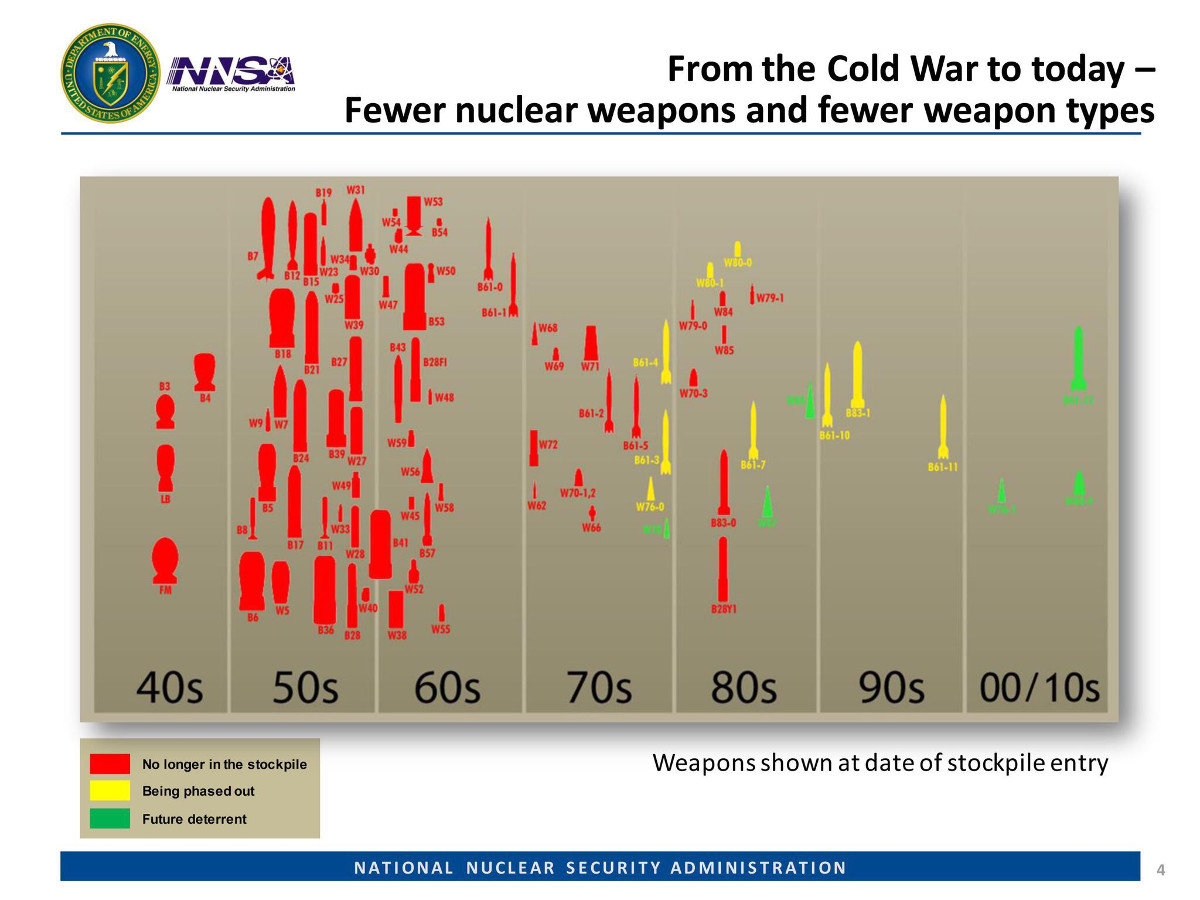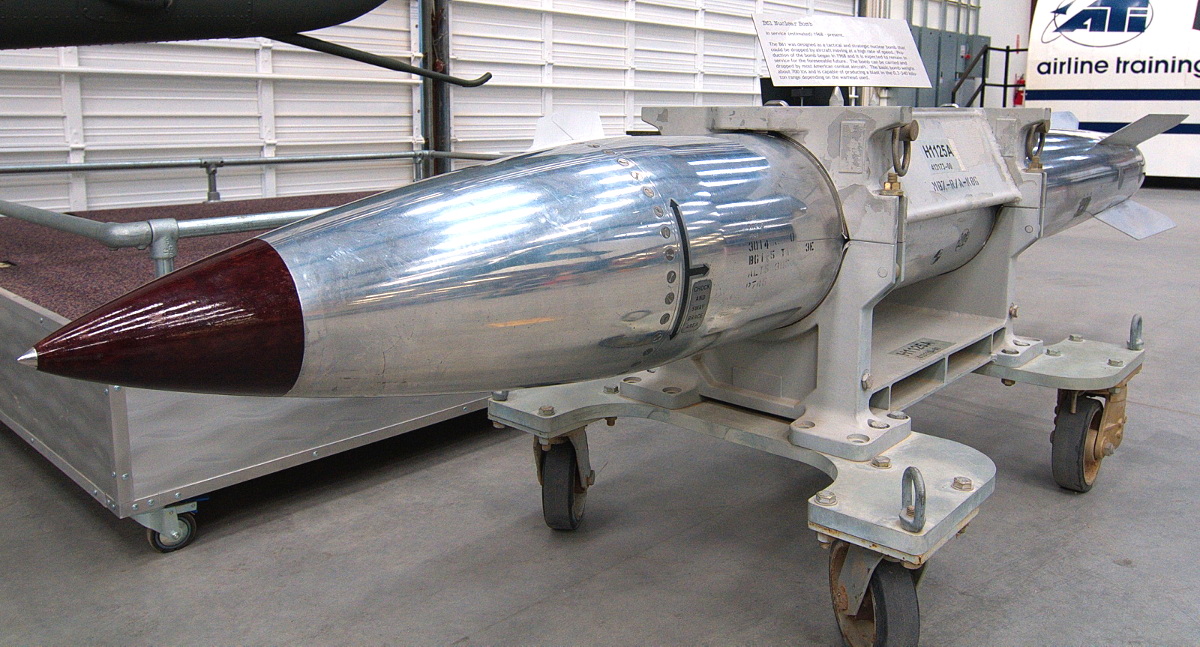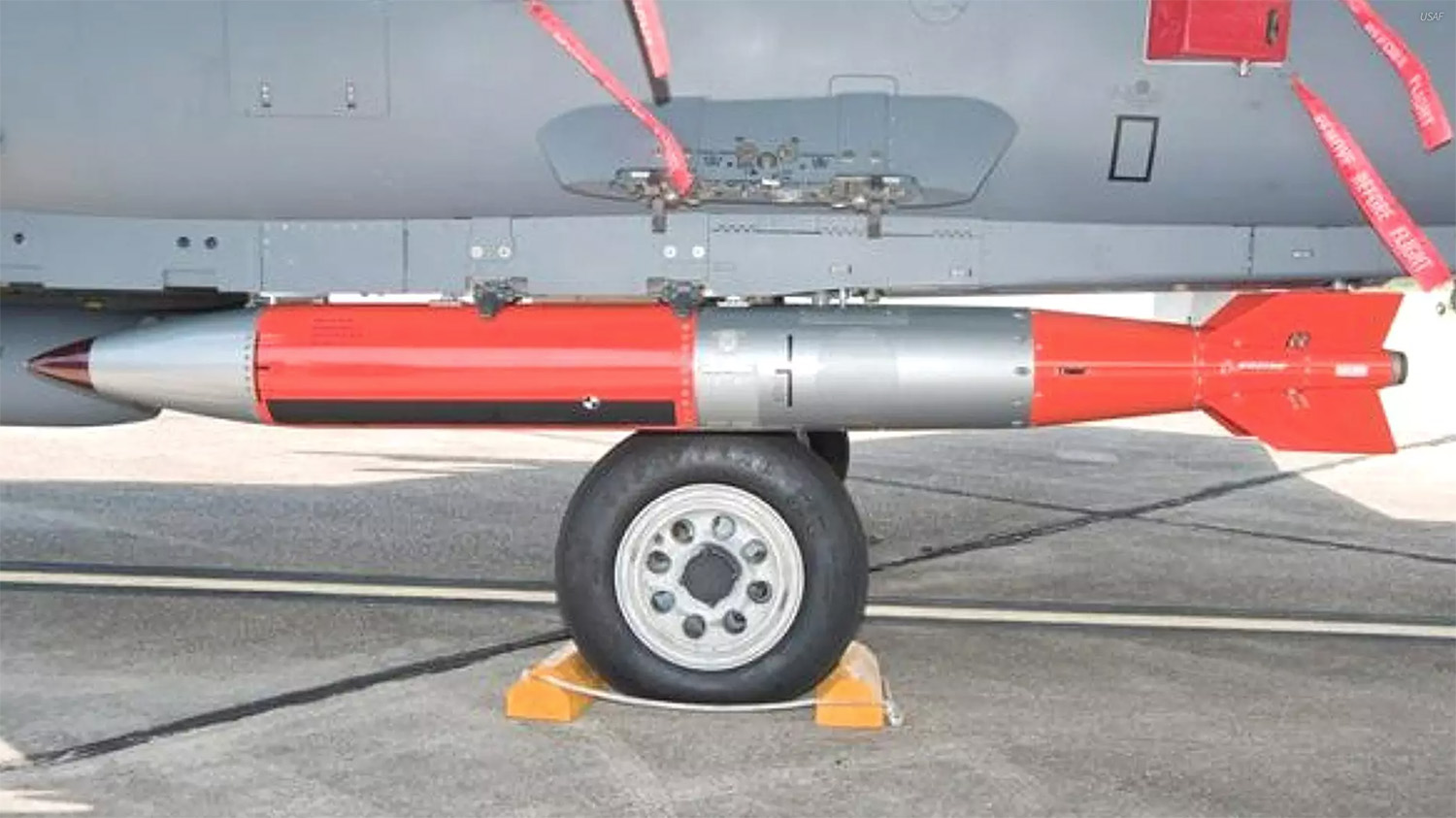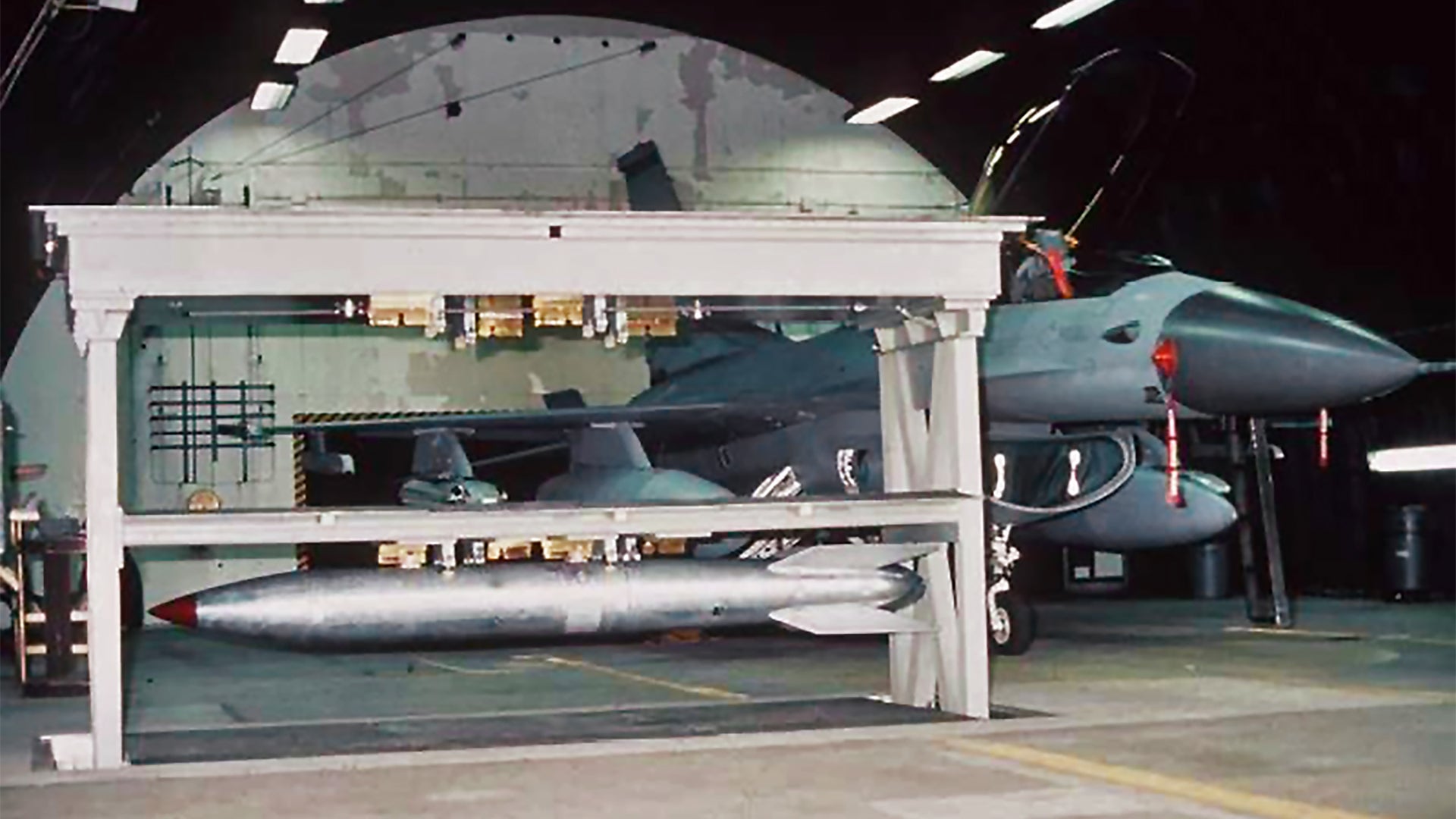When the U.S. military released its latest Nuclear Posture Review, the most significant weapon-related details were plans to install lower yield warheads in submarine-launched ballistic missiles and develop a new nuclear-armed sea-launched cruise missile. Less eye-catching were discussions about maintaining stockpiles of B61 gravity bombs, a family of weapons with a long and colorful lineage that has already been in service for nearly 50 years in various forms, for the foreseeable future.
According to the new Nuclear Posture Review, or NPR, which the Pentagon unveiled in February 2018, the latest version of the B61, known as the B61 Mod 12 or B61-12, will begin entering service in 2020. At that point, it will begin replacing all of the remaining variants of the weapon, which have kiloton-class yields, still in service – the B61-3, -4, -7, and -11 – as well as separate stocks of B83 Mod 1 bombs, which have a much larger megaton-class yield. B83-1 is an improved version of that bomb, which first entered service in 1983. President Barack Obama’s Administration in the previous NPR had said that the U.S. military could safely retire the B83-1s before the B61-12s arrived, a position President Donald Trump’s Administration apparently does not share.
The B61-12 has been in development since at least 2011 and will be the first in the series to feature a precision guidance capability. They will have a GPS and inertial navigation system (INS)-directed tail kit and strakes along the weapon’s main body similar in form and function to those on conventional Joint Direct Attack Munitions (JDAM) bombs.
The weapon’s thermonuclear warhead will reportedly have a maximum yield of approximately 50 kilotons, but personnel on the ground will almost certainly be able to further reduce that using a so-called “dial-a-yield” feature that effectively limits the extent of the nuclear reaction in the “physics package” at the warhead’s core when the weapon detonates. Some older B61s have settings as low as 0.3 kilotons – 50 times less powerful than Little Boy, the bomb the United States dropped on Hiroshima, Japan in 1945.

The primary delivery systems for these weapons will be the existing B-2 Spirit and future B-21 Raider stealth bombers. These aircraft have the necessary low-observable and other protective features to successfully penetrate into high risk areas, potentially full of advanced fighter aircraft and networked air defenses, to drop the relatively short-range bombs onto their targets. The B-52, which will serve for decades to come, lost its nuclear gravity bomb capability due to its vulnerability to air defenses.
In addition, the U.S. military will continue to forward deploy a smaller number of the weapons at various sites in Europe as a potential weapon for American and allied “dual-capable” combat aircraft, such as the U.S. Air Force’s F-15E Strike Eagles, F-16 Vipers and eventually its F-35A Joint Strike Fighters, as well as other tactical jets belonging to NATO. There have also been discussions about re-establishing stockpiles of these weapons in East Asia in light of growing threats from North Korea.

The U.S. military expects to finish production of the B61-12s – which experts believe will total between 400 and 500 bombs – and replacing the existing types by the end of 2024, at which point, this series of bombs will have been in service for more than 55 years.
The United States first started work on the weapons in 1961 as a result of the need for a new, more aerodynamic nuclear bomb that was better suited for use on then new high-performance jet aircraft, some of which were capable of reaching supersonic speeds.
Los Alamos National Laboratory in New Mexico, which the Department of Energy’s National Nuclear Security Administration (NNSA) oversees today, built the first prototypes, initially known as TX-61s, in 1963. Difficulties during the engineering design phase meant the first B61-0s did not enter full-scale production until five years later.
Over the next decade, U.S. nuclear engineers steadily improved the capability, reliability, and safety of the design. All of the B61s came in two basic flavors, “strategic” versions for larger city-size targets and “tactical” variants for smaller site and even potentially for battlefield use against enemy troop concentrations, with the only real differences being in the available, selectable yields. Since most of the exact information is classified, open sources often disagree, but what follows is based on our best accounting of the information available.

The original B61-0 and -1 weapons had “strategic” yields ranging from 10 to 300 kilotons. The B61-1 reportedly differed from the first version mainly in that it lacked any sort of Permissive Action Link, or PAL.
PALs are, broadly, safety devices to prevent unauthorized use of a nuclear weapon, the exact specifics of which are classified. However, the U.S. government has developed broad and publicly available categories for the devices.
The 500 B61-0s had a “Category B” device, which consisted of electromechanical switches that would function and arm the weapon only if an individual put in the appropriate four-digit code. On aircraft, the crew could do this in flight using a wired connection to the bomb, allowing units to launch aircraft with live weapons in a contingency, but with the added safeguard of not arming them until receiving an actual order to proceed with a strike.
A seperate control panel, seen in the video below, controlled other functions, including height of burst and delay in detonation. The latter feature, coupled with a parachute or ballute retarding systems, could allow a low- and fast-flying combat aircraft to “lay down” the bomb and still safely escape the blast area.

It’s not entirely clear why the B61-1 lacked the PAL safety feature, but it may have had to do with the fact that some of the 700 of these weapons went into stockpiles set aside for NATO allies to use in a crisis. U.S. and allied leaders may have determined the need for American personnel to get the codes and then pass them along to third party crews would have been too time consuming a process to make for a credible deterrent capability.
Whatever the case, every subsequently bomb had some type of PAL, as well as a manual “command disable” system that crews on the ground could use to disarm the weapon completely in an emergency. Afterwards, the bomb would be largely useless until specialized personnel reactivated it at a depot. Although it’s still debated if this feature could stop a well resourced state or entity from putting the nuke to use if they had considerable time.
The 235 B61-2s, tactical variants with yields ranging from 10 to 150 kilotons, featured a Category D PAL. This device required a six-digit code, which an operator only had one chance to enter correctly before the system locked up, and could accept multiple code sequences that would either set the weapon to a “safe” training mode or deliberately disable it if necessary.
The B61-3 and -4 had Category F PALs, the most advanced type, which do allow for multiple attempts, but use a 12-digit code sequence. These devices also link those codes to the desired yield, allowing crews to set that in flight.

The two weapons were also the first to use an insensitive explosive in the warhead, necessary to kickstart the nuclear reaction. This made the charges less likely to explode and potentially cause the weapon to function inadvertently in the event of an accident.
Though both bombs were tactical variants, the B61-3 featured eight separate yield settings – 0.3, 1.5, 5, 10, 45, 60, 80, or 170 kilotons. The B61-4 had few options, ranging from 0.3 to 50 kilotons. The United States built nearly 550 and 700 B61-3 and -4 bombs, respectively.
The B61-5 had the same yield as the B61-1, but added a Category D PAL. These 265 bombs were also the first to incorporate Enhanced Nuclear Detonation Safety (ENDS) features that better protected the bombs from physical shocks, extreme temperatures, electromagnetic interference, and any other “abnormal conditions.” At its most basic, an ENDS set up isolates the portions of the warhead that are essential for its functioning inside a shell that keeps out any unwanted “energy.”

It’s not clear, but it appears that the United States refitted many older weapons with those features afterwards, as well. Whatever the case, the B61-5 represented one of the last “new” versions of the bomb.
With the exception of the B61-10, all of the subsequent versions were upgrades of existing bombs. The B61-0 was to serve as the basis for first the B61-6 and then the B61-9, which would have Category D and F PALs respectively, but the U.S. government canceled those projects. Plans to rebuild the older Mod 2s and 5s as the B61-8 using warheads with insensitive explosives similarly did not come to pass.

In the 1980s, the remaining 600 B61-1s did get Category D PALs and warheads with ENDS and insensitive explosives, becoming B61-7s. These strategic weapons also had slightly increased maximum yields of approximately 340-360 kilotons.
The B61-10 is something of an oddball. When the U.S. military was developing the Pershing II tactical short-range ballistic missile, it determined that this weapon would be more useful on a European battlefield against the Soviet Union and its allies if it had a lower yield than the older Pershing I. American weapons designers decided to modify the warhead from the B61-4, resulting in the W85, which had selectable yields from 5 to 50 kilotons.
But in 1987, the United States and the Soviets signed the Intermediate-Range Nuclear Forces Treaty, or INF, which banned the Pershing II. Not wanting to waste the perfectly good warheads for those missiles and since they were already based on the one inside the B61, the U.S. government rebuilt them into 215 B61-10s, with yields ranging from 0.3 to 80 kilotons and a Category F PAL.

The most recent operational variant, the B61-11, entered service in 1997 and is the first to dramatically differ in form, as well as function. The U.S. military treats this version as a combination tactical and strategic bomb even though it’s based on the B61-7 and reportedly has a single, maximum yield of approximately 340-400 kilotons.
The bigger difference, though, is that it has a significantly reinforced shell, possibly with a depleted uranium penetrating nose section, a delay fuzing system, and a booster rocket motor in the rear, all so it can break into deeply buried, hardened facilities. There are less than 100 of these bombs in existence, according to publicly available data, and the United States more or less built them with one specific target in mind.
In 1996, Russia finished work on its Kosvinsky Kamen bunker, part its so-called “continuity of government” plans to protect senior leadership in the event of a nuclear strike or other major emergency. Similar in concept and reportedly similarly—if not better—protected than the U.S. military’s Cheyenne Mountain Complex or Site R, also known Raven Rock, the Kremlin built it specifically to be hardened against nuclear weapons going off up above. The B61-11’s job was to put even those defenses beyond reach in what would likely already be an apocalyptic scenario.
Before the B61-11, the United States planned to use a much less elegant approach when it came to nuclear bunker busting, relying on aging B53 bombs, a design dating back to 1958 for this purpose. These 12-foot long, 4-foot wide, nearly 9,000 pound weapons would have used the sheer explosive power of their 9 megaton yield to create massive craters and crush underground targets. The U.S. government also explored using a modified B83-1, with its 1.2 megaton yield, for the role before deciding on the modified B61.

Now, the U.S. military says the future B61-12’s precision guidance coupled with this low-yield warhead, which will also produces less radioactive fallout, will make these weapons more flexible and suitable for a wider range of contingencies than any of the existing types. It will still be just a modified B61-4 at its core, possibly even using the same basic physics package, though the design may also end up cannibalizing parts from the B61-3s, -7s, and -11s as they head off to the specialized Pantex Plant in Texas for dismantlement.
The new bombs will apparently even allow it to replace existing bunker-buster B61-11s, though its not entirely clear how and the U.S. military has been especially tight-lipped on this particular point. Test footage has shown the weapon is able to at least embed its entire length into the ground, but if it does use the B61-4 shell, it won’t have any of the -11’s added penetrating features.

In 2014, former U.S. Air Force Chief of Staff General Norton Schwartz, speaking at event at the Stimson Center think tank in Washington, D.C., described the weapon’s precision guidance as being key to the weapon’s bunker-busting capabilities, since the bomb would be able to focus its blast more acutely onto a target. The B61-11’s penetrating features and particularly high-yield were, at least in part, to help offset its inherent inaccuracy as an unguided weapon, but would still be significant more capable in breaking through to underground facilities that a bomb without any sort of deliberately hardened casing.
“The B83-1 and B61-11 gravity bombs can hold at risk a variety of protected targets,” the NPR makes clear, though. “As a result, both will be retained in the stockpile, at least until there is sufficient confidence in the B61-12 gravity bomb that will be available in 2020.”
Whatever its bunker-busting capabilities actually are, critics have warned that the various improvements and expanded capabilities the B61-12 offers may also make the U.S. government feel the weapons are more “usable” and increase the likelihood of a nuclear exchange. The United States notably does not have a “no first use” policy with regards to nuclear weapons and reserves the right to use them in response to non-nuclear strikes in certain circumstances, which you can read more about in detail here and here.

The B61-12 has also been controversial because of its cost. Just in 2012, the official cost estimates for the surged from $4 billion to $10 billion. This figure did not include the funds necessary to develop the tail kit – another $1.2 billion at the time – or other components. If it takes at least 400 of the weapons to adequately replace the four existing types, this means each individual 700-pound bomb will be literally worth more than its weight in gold.
Part of that seems to be a product of the decision to use the old B61-4s as the basis for the new bombs. Though the United States built nearly 700 of them, it only has around 200 in active stockpiles. To make up the difference, the U.S. government will have to dig out another 200 to 300 of the weapons and make sure they’re in safe, working order before it even begins to upgrade them into the new B61-12 configuration.

All of this has prompted experts to question the actual necessity of the weapon, especially in context of the U.S. military’s other nuclear modernization efforts and conventional weapons plans and with so few aircraft expected to serve as delivery systems and in such limited context. On top of the B61-12, the U.S. Air Force is in the process of developing a new nuclear-capable, air-launched cruise missile and is buying more massive, conventional, precision-guided bunker buster bombs that only the B-2 and potentially the B-21 will be able to carry. Those weapons will be capable of holding hardened targets, such as enemy’s buried command and control facilities, strategic weapons sites, and bunkers for their senior military and civilian leadership, at risk, too, but they aren’t as capable of a penetrating nuclear warhead.
Of course, it’s equally worth pointing out that a B-2 or B-21 bomber could be able to carry many more B61-12s than nuclear-tipped Long Range Stand Off cruise missiles or conventional GBU-57/B Massive Ordnance Penetrator bombs. As such, an individual aircraft with the nuclear bombs could potentially strike more targets in a single sortie.

In addition, American commanders can still decide recall bombers carrying gravity bombs even late in their mission, giving them more time to respond to changing circumstances or new information, making this combination perhaps the most flexible nuclear weapon system the United States has at its disposal. Whether or not this justifies the B61-12 costs remains open for debate.
The issue of whether or not it remains useful to forward deploy B61s of any type at bases in Europe is a separate and complicated question that is much more related to the political proclivities of America’s NATO allies than the actual capabilities of the weapons. We at The War Zone have previously discussed those matters in detail, which you can find here and here.
But at least at present, the United States remains committed to maintain a stockpile of B61 gravity bombs for decades to come. And if it continues with the plan laid out in the latest NPR, by the end of the 2020s, they could easily be among the oldest nuclear weapons, as least when it comes to their physics package, that the U.S. military still has in active service.
Contact the author: joe@thedrive.com
